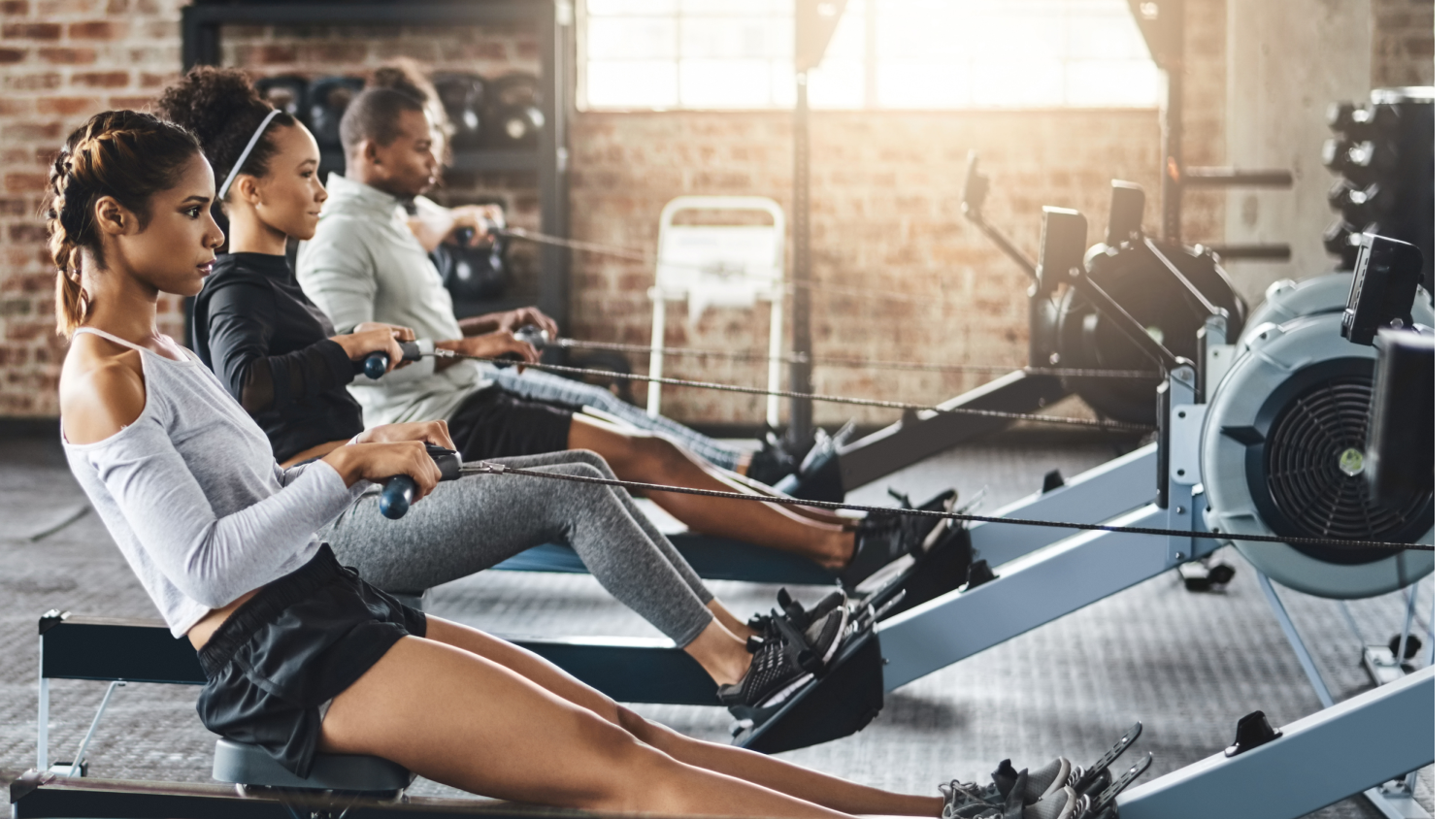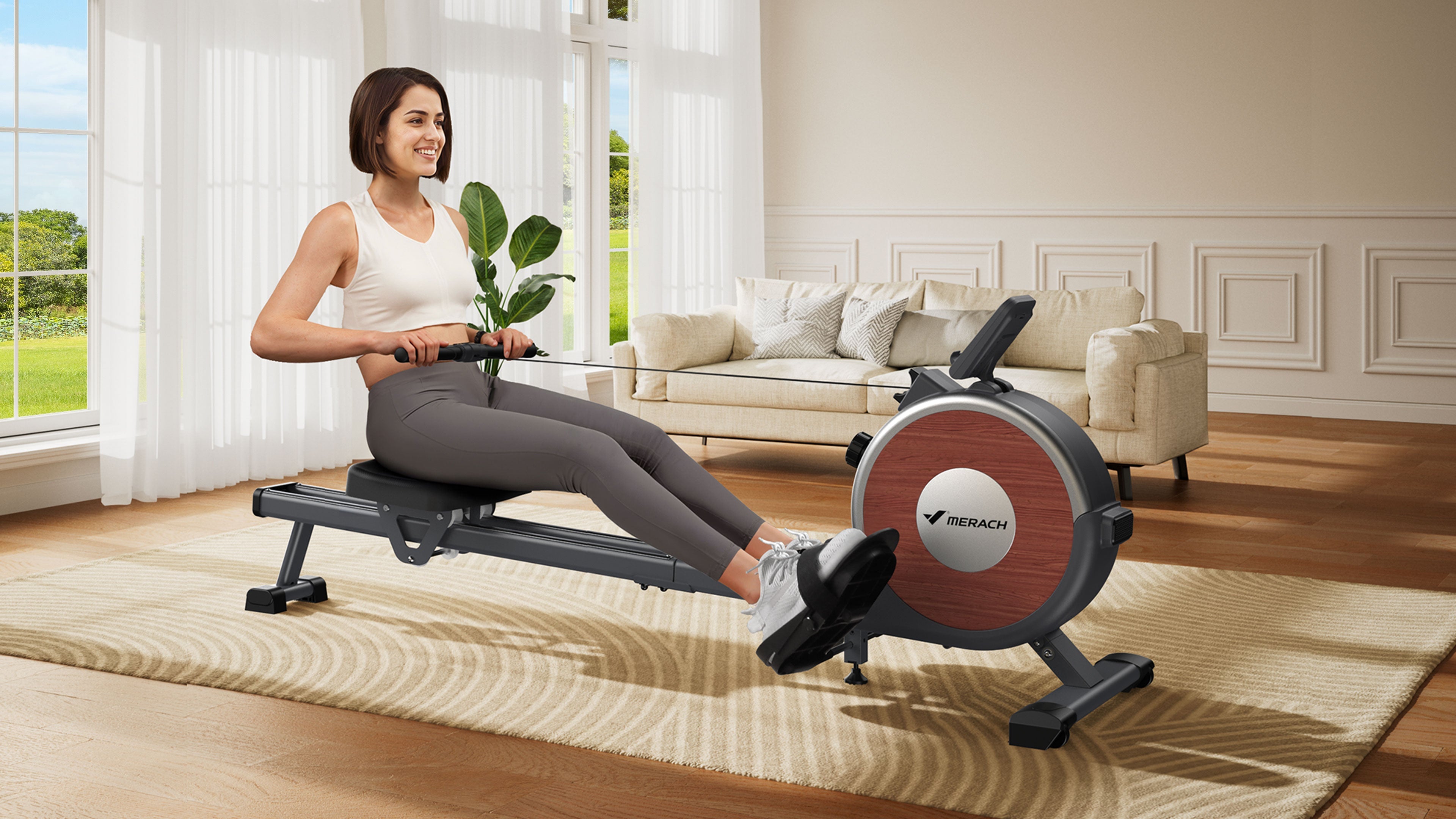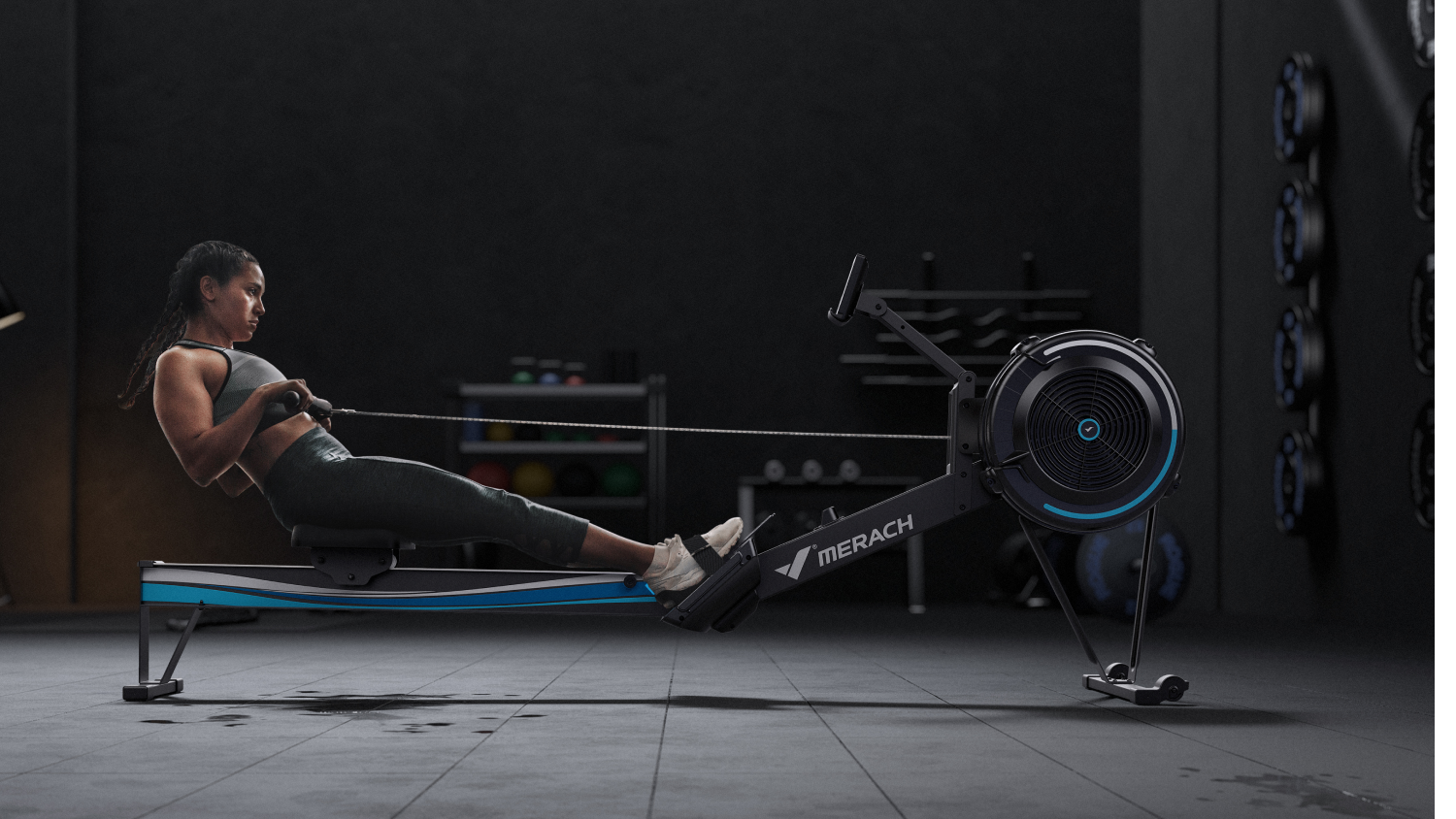Recently, rowing machines have become super popular and sparked a lot of buzz in the fitness world. You'll find them in almost every gym's cardio section, and they've even climbed to second place in the rankings for fat-burning equipment. But the big question is, does a rowing machine build muscle, or is it all just hype?
In this article, we'll explore what does a rowing machine work, how rowing machines contribute to muscle, and provide you with 5 effective rowing machine workouts that will help you build muscle. Don't be intimidated by new equipment. Follow our tutorial and you'll find that using a rowing machine is actually very simple.
1. What Does a Rowing Machine Work?
The origins of modern rowing machines date back to the 19th century. Back in 1872, Mr.WB Curtis patented the first rowing machine in the U.S., which featured a flywheel and ratchet system. While this early version looked nothing like the machines we use today, it laid the groundwork for the indoor rowing machines we see in gyms now.
However, outdoor rowing can be heavily impacted by weather conditions, so in 1976, Dike and Pete Dreissigacker set out to create a more practical solution, which would not be limited by location or weather. This innovation brought rowing training indoors, leading to the creation of the indoor rowing machine. Once introduced, it quickly gained popularity among athletes and fitness enthusiasts and was widely promoted in Europe, especially in Germany.
In modern rowing machines, air resistance and magnetic resistance are the two most commonly used systems. In addition, there is also a water resistance rowing machine designed for the closest experience to rowing on water. They are often combined with wooden frames to offer a truly premium training experience.
A rowing machine is made up of a sliding seat, a rail, a pull handle, and a resistance mechanism. It recreates the feel of rowing on water by using the flywheel’s inertia and resistance. As you pull the handle, the flywheel spins, creating the drag that mimics real rowing.
Advantages Over Other Fitness Equipment
Unlike traditional cardio machines, a rowing machine combines strength training with cardiovascular work, offering a unique advantage for muscle development. Here are some main benefits of rowing machines:
- Low-Impact exercise: It does not cause joint impact like other sports, such as running, because you slide on the seat and the resistance is spread evenly across your body. It reduces the risk of injury.
- Full-body workout: Rowing machines activate both upper and lower body muscles, making them more effective than most machines that only target one muscle group.
- Improve cardiovascular: Rowing is one of the few exercises that strengthens muscles and improves cardiovascular fitness at the same time. With the right use, rowing works the cardiovascular system.
2. What Muscles Does a Rowing Machine Work?
Many people mistakenly think it's just upper-body training. Actually, rowing activates about 86% of your muscle groups, including your back, biceps, triceps, trapezius, and forearms. This makes training on a rowing machine an effective workout for the entire body. By activating so many muscle groups at once, you burn more calories and improve your overall strength and endurance.
Phases of Rowing Machines
The rowing cycle can be divided into 3 phases, each engaging different muscle groups:
| Phases | Action Guidelines | Muscles Worked |
|---|---|---|
| Catch | Sit down with your feet firmly planted and strapped to the platform and your hands gripping the bar. Adjust the seat so that your shins are perpendicular to the floor, keeping your arms straight and your upper body leaning slightly forward from the hips. | Quads, hamstrings, glutes, and calves. |
| Drive | Make sure you are using your legs at the beginning to push backward. In the middle of the movement, when you feel a little resistance in the cable, pull the cable backward. Keep it level with the front of the machine as you finish the movement. | Legs, back, arms, and core |
| Return | Hold the cable return to the starting position in a controlled manner. When your hands pass your knees, bend your knees and gradually slide the seat forward to return. | Triceps, biceps, and forearms |
Rowing Machine Muscles: Before and After
As we mentioned, rowing machines provide a compound workout that effectively redefines the proportions of your whole body muscles, not a specific group, as arms or legs. It develops a sporting figure: fit, slim, and most turbulent, and considerably increases cardiac power and muscle capacity.
The modern worker is known to sit in front of the computer all day, which leads to weaker legs, a loose core, or dependence on the lumbar spine. Also, one can have rounded shoulders or a hunched back. According to research, rowing is about 50% legs, 30% glutes, and the last 20% core/back. With regular long-term training on the rowing exercise machine, your leg muscles will be firmer, your core will become stronger and more stable, and your body posture will demonstrate a significant change.

3. 5 Effective Rowing Machine Workouts to Build Muscle
Although rowing machines work the full body, like any other equipment, if it is not used properly, we will only overload the muscles involved, increase the chances of injury, and fail to achieve our goals. To effectively harness the muscle-building potential of your rowing machine, we provide 5 simple home rowing machine workouts for beginners.
Row Machine Workout 1: Seated Low Row
The lower and middle portions of the latissimus dorsi are the primary muscles worked on a seated rowing machine. This exercise is low-impact on the lower back, making it suitable for those with sensitive lumbar regions. If you want to build back width and thickness, such as achieving an inverted triangle physique, the low row machine workout is a good choice.
Muscles worked:
- Back: Lats, Rhomboids, Traps
- Arms: Biceps, Forearms
How to perform:
- Adjust the resistance to your desired level.
- Take a seat and secure your feet on the pedals. Tilt your upper body forward just a bit, keeping your knees softly bent and your back in a neutral position.
- Make sure your shoulders are relaxed, your chest is lifted, and your shoulder blades are pinched together.
- Draw the handle in toward your body, keeping a slight bend in your elbows. Stop when your arms are bent at a 90-degree angle, then repeat the movement.
Sets & Reps: 3 sets * 10-12, with 60 seconds rest

Row Machine Workout 2: High Rowing
Compared to low rowing, the upper back and rear deltoids are the muscles worked by the high row machine. It focuses on scapular retraction and less on shoulder extension. It helps strengthen the upper and middle back, improving rounded shoulders and hunched posture. If you want to enhance your upper back definition, incorporate this exercise into your row machine routine.
Muscles worked:
- Back: Traps, Rhomboids, Deltoids
- Arms: Forearms
How to perform:
- Set up the handles at shoulder height when you grip the handles and the resistance level.
- Take a seat, hinge forward a bit, keep your knees softly bent, and hold your spine in a neutral position.
- Make sure your shoulders are relaxed, your chest is lifted, and your shoulder blades are pinched together.
- Pull the handle down until your arms are bent at a 90-degree angle, then repeat.
Sets & Reps: 3 sets * 8-12, with 60 seconds rest

Row Machine Workout 3: Rowing Pyramid Workout
Pyramid rowing machine workouts are excellent for beginners to challenge muscles and build endurance progressively. The pyramid means that you increase the intensity over time. It's an effective method for improving both strength and endurance.
Muscles worked:
- Legs: Quads, Hamstrings, Glutes.
- Back: Lats, Traps, Rhomboids
- Arms: Biceps, Forearms, Triceps
How to perform:
- Start with a 5-10 minute easy row to warm up, then set your time intervals.
- Row hard for 1 min, and rest for 1 min.
- Row for 2 min at higher intensity and rest for 2 min.
- Row for 3 min at middle intensity and rest for 3 min.
- Then, reverse the pyramid.
Sets & Reps: 15-20 minutes, including rest periods
Row Machine Workout 4: 500 Meter Sprints
The high force and fast pace of a 500m sprint recruit muscle fibers differently than a steady-state workout, emphasizing power and speed. It is a powerful, time-efficient rowing routine that combines cardio conditioning with muscle strength and endurance training.
Muscles worked:
- Legs: Quadriceps, Hamstrings, Glutes, Calves
- Back: Lats, Rhomboids, Traps
- Arms: Biceps, Forearms, Triceps
- Shoulders: Deltoids
How to perform:
- Warm up for 5-10 minutes of light rowing to prepare.
- Set your rower's distance for a 500-meter.
- Begin with 3-4 fast, powerful strokes to quickly accelerate the flywheel.
- Row 500 meters at 90-100% effort.
- Cool down with 5 min of slow rowing.
Sets & Reps:
- Beginner: 4-5 sprints, interval 2-3 min
- Intermediate: 6-8 sprints, interval 1.5-2 min
- Advanced: 8-10 sprints, interval 1 min or less
Row Machine Workout 5: High-Intensity Interval Rowing
HIIT rower workout is an effective method for building muscle and burning fat. It alternates between bursts of maximum effort and short recovery periods. It is challenging for beginners, but it can enhance rowing machine skills.
Muscles worked:
- Legs: Quads, Hamstrings, Glutes
- Back: Lats, Rhomboids, Traps
- Arms: Biceps, Forearms, Triceps
- Shoulders: Deltoids
How to perform:
- Do 5-10 minutes of light rowing at a comfortable speed to warm up
- Row at 80-95% effort for 30 seconds to 1 minute.
- Then row at 50-60% low intensity.
- Rest completely for 1-2 minutes.
- Continue cycling for a set number of rounds.
Sets & Reps:
- Beginner: 6-8 rounds, 30s high, 90s low
- Intermediate: 8-10 rounds, 45s high, 60s low
- Advanced: 10-12 rounds: 60s high, 60s low
4. Common Mistakes When Rowing
It may appear to be a mere push-and-pull movement on the face of it, but it is not. When rowing, it is important to use the proper form and technique to avoid injury and make your rowing machine workouts effective.
Use Too Much Arm Strength
Excess relying on arms and back is one of the most common mistakes that beginners commit. When rowing, you should use your leg power most of the time and use your arms and upper body to support. Excess arm force may cause overuse and injury.
Round The Back
Another common mistake is leaning forward and curving your back. This can cause back pain and reduce the effectiveness of your rowing machine exercise. Instead, maintain an upright posture and keep your back straight.
Make Sudden Movements
It is also important to perform the movement in a smooth and controlled manner rather than making sharp movements. If you reach excessively, you risk straining the hamstrings and lower back, and recovering too quickly limits muscle use and breaks your rhythm. In conclusion, in the case of any rowing machine workouts, the main focus of the exercise should be the sensation of pulling with your legs, then your core, and back. Your arms are involved in the pull but not overworked. If you experience considerable tension in your lower back, change your position.
5. FAQs about Rowing Machines
Beginners often have some questions when first using rowing machines. We've gathered some typical questions about rowing and answers for them.
Q1: How long on a rowing machine to build muscle?
How long you spend on the rowing machine depends on your fitness level and training objectives. For beginners, we recommend starting with short sessions of 10 to 15 minutes per day. You can gradually increase this to 30-45 minutes over time. It's also important to vary the intensity of your training to keep making progress-try incorporating interval training or adjusting the resistance level on the rower.
Q2: Can I use a rowing machine at home?
Yes. Nowadays, there are numerous rowing machines for home available. They provide the same benefits of burning fat and building muscles as in the gym, so you can enjoy a good workout from the comfort of your home. Moreover, they're compact enough to fit into any space, while still delivering a highly effective full-body workout. With adjustable resistance and near-silent operation, you can challenge yourself at any intensity without disturbing those around you.
Q3: How many calories does a rowing machine burn?
Calories burned on a rowing machine will depend on your body weight, intensity, and the length of the activity. An average-weight person with a weight of 150 pounds will burn about 200-300 calories in 30 minutes of rowing at moderate intensity. HIIT on a rower is capable of causing a significant caloric expenditure.
Q4: How long on a rowing machine to lose weight?
Although the rowing machine is ideal for losing weight, sustainable weight loss requires a combination of routine exercise and caloric deficit. Prepare a 30-day weight loss plan with a rowing machine and adhere to it, with a balanced diet. Within several weeks, you are likely to see the results.
6. Conclusion
So, will a rowing machine build muscle? The answer is yes. If you're looking for the best affordable rowing machine for home, the Merach Q1S Resistance Rower is a great choice, offering adjustable resistance and a smooth rowing experience.
By incorporating these 5 effective rowing machine workouts into your routine, you can significantly enhance your muscle strength and endurance. Start using the rowing machine today, and begin building strength and muscle!






























Leave a comment
This site is protected by hCaptcha and the hCaptcha Privacy Policy and Terms of Service apply.